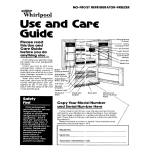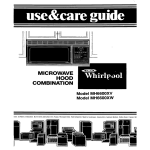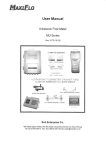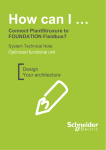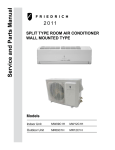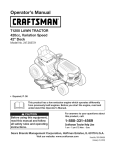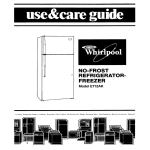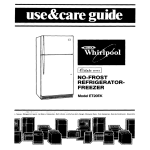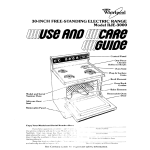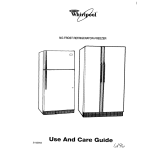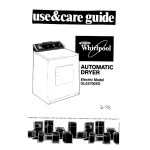Download Whirlpool ET14JK Refrigerator User Manual
Transcript
NO-FROST REFRIGERATOR-FREEZER Model ET1 4JK USC Guide Please read this Use and Care Guide before you do anything else... It will help you get the longest useful life your refrigerator can give It tells you how to start your refrigerator, clean it, move shelves and adjust controls It even tells you what to do if you hear strange sounds or think something is wrong. Treat your new refrigerator with care. Use it only to do what home refrigerators are designed to do. It will pay you back with the years of service It was built to give Control Shelves Crisper Cover \ Copy Your Model Number and Serial Number Here Model \ %“ii’,Number ‘I If you have to call for service, the service technician will ask for your Model and Serial Numbers. Your refrigerator has these numbers on a plate inside the refrigerator, on the left wall at the bottom. You may h’ave to remove the crisper to read it. (See page 5 for instructions on removing the crisper.) Copy the numbers in the spaces below while you are thinking about it. Keep this book in a handy place, and keep your warranty and sales slip with it. Model No. Serial No. Purchase Date and Before you plug it in IMPORTANT This IS the only fine print you’ll find :n this booklet Please read it tc be sure you use your refrigerator properly We build refrigerators to last, but we can’t control how they are used Before using your refrlgerator, you ure personally responsible for making sure that it l IS installed ar:,l leveled on a floor that WIII hold the weight, a,id in an area suitable for iis size and tise l IS connected Jnly to the right kind of outlet, with the right electrtc supply and grounding IS used only for jobs expected of home refrigerators l IS properly maintained. . IS out of the weather. l IS used in an area where the room temperature will not fall below 55 F. (13 C). l IS not run where there are explosive fumes l IS not used by children or others who may not understand how it should be used . IS not loaded with food before it has time to get properly cold l Pick the Right Place. Save steps by putting your refrigerator near the sink and next to a It should not be near a stove, radiator, water heater or any source of heat...including direct sunlight. You can install it flush against cabinets on each side. You should leave 3 inches (7.5 cm] of free space above the top, and at least 1 inch (2.5 cm] between the condenser and the wall. These spaces let the condenser “breathe.” Do you want it in a corner? Leave some room on the wall side if you want the doors to open wider. Planning to add the automatic ice maker? Will the refrigerator be near a cold water pipe? Some people run the water line through the floor to the basement. Others run it behind the cabinets to the pipes under the sink. countertop. Make Sure It’s level. .eg Keep the 4 bolts that hold your refrigerator in the shipping crate. They are the levelling legs. Screw these bolts all the way into bolt holes at the bottom corners of the refrigerator. Roll refrigerator into place. Next, lower legs enough to lift the rollers off the floor. Adjust each leg until the refrigerator won’t rock. Adjust the front legs to level the refrigerator. To raise the corners, turn legs counterclockwise; to lower the corners, turn legs clockwise. Check with a level. Remove the label wall receptacle Refrigerator Power Cord Recommended Grounding Method 2 and Clean. Remove the Consumer Buy Guide label, tape and any inside labels before using the refrigerator. To remove any remaining glue: 1. Rub briskly with thumb to make a ball, then remove. OR 2. Soak area with dishwashing detergent solution (1 teaspoon detergent in 1 quart warm water) before removing glue as described in step 1. DO NOT USE rubbing alcohol or flammable or toxic solvents, such as acetone, gasoline, carbon tetrachloride, etc. These can damage the material. DO NOT REMOVE any permanent instruction labels inside your refrigerator. DO NOT REMOVE the Tech Sheet fastened under the refrigerator at the front. Plug It In. A 115 Volt, 60 Hz., AC only, 15 or 20 ampere fused and grounded electrical supply is required. It is recommended that a separate circuit serving only this appliance be provided. Do not use an extension cord. Use a receptacle which cannot be turned off with a switch or pull chain. Cleaning your refrigerator Both the refrigerator and freezer sections defrost automatically. But both should be cleaned about once a month to help prevent odors from building up. Of course, spills should be wiped up right away To clean Your refrigerator, unplug it, turn the Refrigerator Control to OFF, take out all removable parts, and clean it according to the following directions. Inside. You can wash the parts You take out in the sink with a mild soap or mild detergent and warm water. Harsh cleansers, scouring powders and solvents should never be used on any part of Your refrigerator. Wash the walls with a solution of two tablespoons (309) of baking soda mixed with one quart (ll) of warm water. Rinse well and dry. Let the freezer warm up with the door open for 10 or 15 minutes so the cloth doesn’t stick The inside of the door, including the gasket, should be washed with warm water and a mild soap or mild detergent. Do not use cleaning waxes, concentrated detergents, bleaches or cleansers containing petroleum products. They can damage the gasket and plastic finish. Outside. Wash the outside with warm water and a mild detergent. Rinse well and dry. Waxing is recommended in high humidity areas. Use a good auto paste wax or an appliance wax on painted metal surfaces. Do not use on plastic because it may damage these parts. Underneath. Much of the floor under the refrigerator can be reached without moving It. To reach all of the area for more thorough cleaning or to clean the defrost pan, You will have to move the refrigerator Follow the directions below if you want to move it. Behind. Wipe Inside of Pan Clean \ Dust from Coils To clean the condenser coils or the floor underneath the refrigerator, slide it out as far as necessary. If your refrigerator is equipped with an automatic ice maker make sure You don’t slide it out farther than the water supply line allows. You will see the defrost pan on top of the motor. You don’t have to remove it to clean it. Clean dust from the condenser coils with a vacuum cleaner. The condenser should be cleaned every two or three months. The condenser acts like an air conditioner in reverse. Heat is removed from inside your refrigerator and transferred to the condenser. From there, the heat is spread into the room. Dust on the condenser insulates it and reduces the heat leaving it. If the heat can’t get out easily, the refrigerator will have to run longer to keep food cold. Energy Saving Tips. Vou can help your refrigerator use less electricity l Check door gaskets for a tight seal Level the l cabtnet to be sure of a good seal Clean the condenser co11 regularly l Open l the door as few times as posstble l Think about what You need before you open the door Get everything out at one time Keep foods organized so You won’t have to search for what you want Close door as soon as food ISremoved. Go ahead and fill up the refrigerator, but don’t overcrowd it so air movement IS blocked l l It IS o woste of electricity to set the refrigerator and freezer to temperatures colder than they need to be If ice cream IS firm in the freezer and drinks are as cold as your famtly likes them. that’s cold enough Keep the Power Saving Control on CONSUMES LESS ENERGV unless motsture forms on the refrlgerator exterior Make sure your refrigerator IS not next to a heat source such OS a range, water heater, furnace, radiator, or In direct sunlight Using your refrigerator Refrigeiator Control- set On Power Saving 3 Setting Control LightSwitch Freezer Control- Set on B the Controls. The Refrigerator and Freezer Controls are on a console Inside the refrigerator at the top. To start the refrigerator, set the Refrigerator Control to 3 and the Freezer Control to B. When you first turn it on, it will run continuously until the insides are properly cold. It takes time for your refrigerator and freezer to get cold enough to store food safely. Before loading it with food, be sure the refrigerator motor has cycled at least once (turned on, turned off, and turned on again]. This may take up to a day. The following chart gives recommended control settings for a number of operating conditions. RECOMMENDED CONTROL SETTINGS OPERATING CONDITIONS For Normal Use. - Normal number of door openings. - Normal amounts of food added - Normal room temperature. If Refrigerator Section is Too Warm: -Door opened often - Large, warm food load added. - Room temperature very warm. If Freezer Section is Too Warm: -Door opened often. -Large amount of warm food added -Very cold room temperature. If Ice isn’t Made Fast Enough: - Heavy ice usage. - Cold room temperature. If Both Sections are Too Warm: - Doors opened often. -Large amounts of food added. -Very warm---. or cold room temperatures. POWER SAVING CONTROL: It’s normal for moisture to form around the doors when room humidity is high - If morsture forms - If no moisture forms...room low or during heating season. The temperature setting will as cold as you like. If you need way your refrigerator is used, above. Chonge only one control change, If needed humidity Refrigerator Freezer.. 3 B Refrigerator Freezer 4 C Refrigerator Freezer 3 A Refrigerator Freezer 3 A Refrigerator Freezer 4 B REDUCES EXTERIOR MOISTURE is CONSUMES LESS ENERGY be about right when milk or juice are to adjust the settings to match the use the settings suggested in the chart of o lime. Wait o day, then make onother Adjusting Pull Shelf Out Until It Stops. Lift the Front and Pull Agarn Lift the Front, Then the Back the Shelves. Adjust your refrigerator shelves to match your food storage needs for tall items, short items or sizes in between. It will be easier to move a shelf if you take off all the food first. Slide the shelf you want to move toward you until it stops. Lift up the front and slide it out the rest of the way. To put it back on the shelf guides, fit the back of the shelf on top of the guides with the wire stops on the bottom of the guides. Slide it in, keeping the front litted up until the stops on the shelves clear the stops on the guides. Removing - the Crisper and Crisper Cover. To remove the crisper, slide it out until it stops. Lift the front a little and slide it out the rest of the way. The cover rests on nubs built into the side walls of the refrigerator. To remove the cover, lift the front and then the back. To replace the cover, fit the notches in the back corners of the cover over the nubs at the back of the walls. Then lower the front into place. To replace the crrsper, slide It in, keeping the front lifted a little until the crisper clears the stops Pull out to stop. Lift the Front and Pull Again. Replacing the Light Bulb. WARNING: Before removing the light bulb, either unplug the refrigerator or disconnect the electricity leading to the refrigerator at the main power supply. Shock and injury can occur if electricity remains connected. To replace bulb, reach behind the control console to find the bulb. Remove bulb and replace it with a 40-watt appliance bulb. Ice Cube Trays. To remove ice from the flexible ice trays, hold a tray at both ends, as shown. Slightly twist the tray; the ice will come out easily. If cubes are not used for a number of weeks, they may become smaller. The moving air is so cold that it starts a slow evaporation. [That’s also why it’s so important to wrap food carefully.) The longer they are stored, the smaller they can get. Optional ICE MAGIC” Automatic Ice Maker. If you have the automatic ice maker accessory or plan to add one later [Part No. ECKMF-83) there are a few things you will want to know. The ON I OFF lever IS a wtre signal arm. Down...for making Ice automatically; Up .to shut off the Ice maker l Shake the brn occaslonally to keep cubes separated, and to obtain Increased storage capacity. l It IS normal for Ice crescents to be attached by a corner. They will break apart easily l You wtll hear water running when Ice maker is working. You’ll hear ice fall Into the bin. Don’t let these sounds bother you. l The Ice maker will not operate until the freezer is cold enough to make Ice. This can take overnight . Because of new plumbing connecttons, the first Ice may be discolored or off-flavored. Discard the ftrst few batches of ice. l If ice is not being made fast enough and mcxe ice is needed, turn the Refrigerator Control toward a higher number. Wait a day and, if necessary, turn the Freezer Control toward A l If you remove the ice bin, raise the signal arm to shut off the Ice maker. When you return the bin, push it all the way in and lower the arm to the ON position l If cubes are stored too long, they may develop an off-flavor.like stale water Throw them away. They will be replaced, Cubes in the ice bin can also become smaller by evaporation. l The ICE: maker water supply should not be softened water. The chemicals could damage the Ice maker rnolds 5 l A Twist of the Wrists Raise Signal Arm to Stop Ice Maker Lower Signal Arm to Start It Sounds you may hear. Your new refrigerator may make sounds that your old one drdn’t Because the sounds are new to you, you mrght be concerned about them Dorl’t be Most of the new sourds are normal Hard surfaces lrke the Posslble Slight Clicking Sounds: Water or Snapping Sounds: Ice Maker Running Probable Sounds: Hum; Soft hiss: Sounds: Sounds: floor, walls and metal cabtnets can make the sounds seem louder. The followrng chart describes the krnds of sounds that might be new to you, and what may be makrng them Causes: You may hear the refrrgerator’s fan motor and moving air The defrost trmer makes a definite click when the refrigerator It also makes a sound when the refrigerator starts. stops running When the refrigerator stops running. you may hear gurgling In the tubing for a few minutes after it stops You may also hear defrost water running into the defrost water pan If your refrrgerator has an ice maker, you may hear a buzzing (from the water valve), trrckling water and the clatter of Ice dumped Into the brn. Your refrigerator has a high-efficiency compressor and motor It WIII run longer than older designs It may even seem to run most of the time. Short Vacations. Moving. No need to shut off the refrigerator If you ~111 be away for less than four weeks. Use up perishables. freeze other items. If your refrrgerator IS equrpped with an automatic Ice maker, 1) turn It off, 2) shut off the water supply to the ice maker, 3) empty the ice bin. If your refrigerator is equipped with an automatic Ice maker, shut off the ice maker water supply a day ahead of time. Disconnect the water line. After the last supply of ice drops, lift the signal arm to turn off the ice maker. Remove all food. Pack frozen foods in dry ice. Unplug the refrigerator and clean it thoroughly. Remove everything that comes out. Wrap all parts well and tape them together so they don’t shift and rattle. Screw In the levelling legs; tape the doors shut, tape the electric cord to the cabinet. When you get to your new home, put everything back and refer to page 2. If your refrigerator has an automatic ice maker, reconnect the water supply. long Vacations. Remove all the food if you are going for a month or more. If your refrigerator IS equipped with an automatic Ice maker, turn off the water supply to the Ice maker at least a day ahead. When the last load of Ice drops, turn off the ice maker. Unplug the refrrgerator and clean it .rlnse well and dry Tape rubber or wocd blocks to both doors ..keeprng them open far enough for arr to get In. Thus will keep odor and mold from building up WARNING: 6 Tape blocks out reach...do not allow the refrigerator when blocked open. They injured or trapped. To restart refrigerator, of a child’s children near the doors are may become see “Using Your Refrigerator” QUESTIONS? ., .call your COOL-LINE@ service assistance telephone number Food storage guide STORING FRESH FOOD Cured or Smoked Meat and Cold Cuts. Ham bacon. sausage, cold cuts, etc, keep best rn origl ncl wrappings. Once opened, trghtly re-wrap II plastic wrap or aluminum foil. Canned Ham. Store in refrigerator unless the la bel savs it’s okay to store on the shelf. Do not freeze Fresh Poultry.. Wrap in plastic wrap The plastlc wrap on poultry, as purchased, may be used fo storage STORAGE CHART FOR FRESH AND CURED MEAT* Approxlmate (days) We There IS a right ‘way to package and store refrrgercted or frozen foods To keep foods fresher, longer, take the time to studv these recommended steps, leafy Vegetables Remove store wrapping and trim or tear off bruised and drscolored areas Wash In :ola water and drain Place In plastic bag or plastic :onraner and store in crisper Cold, moist err helps <eep leafy vegetables fresh and crisp Vegetables with Skins [carrots, peppers] Store ri crrsper, plastic bags or plastrc container Wash, let dry and store !n refrigerator rn Fruits plcst~c bags or cricper Co not wash or hull berrres ;hr! they are read\ to use Sort and keep berrtes In ‘h,eir store container lri a crisper, or store in a loosely ,;losed paper bag (or- a refrtgerctor shelf Meat IS perishable and expensive ..you Meatwon’t want to waste an ounce of it through careless handlrng. The followtng list and chart give you packaging hints and time Itmrts. Fresh, Prepackaged Meat Store fresh meat rn the store wrapping Vacuum packaged meat can be frozen for as long as one month if the seal IS not broken If you warIt :o keep it frozen longer, you should wrap It with specrc freezer wrapprna material Fresh Meat, Not Prepackaged. Remove the market wrapping paper and re-wrap in alumtnum foil for storing it unfrozen Cooked Meat. Wrap or cover cooked meat wrth plcstrc wrap or clumrnurn foil Store rmmedictely Variety Meats . Chicken _. Ground Beef Steaks and Roasts Cured Meats Bacon _.. ..__. ._, Cold Cuts _, ._.._..__ . Tlme 1 to 2 1 to2 1 to 2 3 to 5 7 to 10 5to7 3 to 5 ‘If meat IS to be stored longer than the times given, follow the drrectrons for freezrng - NOTE: Fresh fish and shellfish should same be used the day as purchased Store without washing In the orrginc Eggs carton or use the egg nest in the door of you refrigerator Milk Wrpe milk cartons For best storage, place rtrlk on interior shelf. Beverages ..Wrpe bottles and cans Store on c door shelf or inside the refrigerator. Butter. Keep opened butter in covered dish or or the Butter Compartment When storing an extra sup ply, wrap In freezer packaging and freeze .Store in the orrgrncl wrapping unto Cheese you are ready to use it Once opened, re-wrap tightly tn plastic wrap or clumrnum foil Condlments Store small jars and bottles (catsup, mustard, jelly, olives) on the door shelves where they are in easy reach. leftovers Cover leftovers with plcstrc wrap or aluminum foil to keep fo& from drying out and trcnsferrlng food odors Plastic containers with tight lids are fine, too *Courtesy or NatIonal ilve Stmk and Meat Boarc FREEZING & STORING FROZEN FOODS 3 The freezer section IS desrgned for storage of commercrally frozen foods and for freezing foods at home Packaglng-The secret of successful freezing IS rn the packaging The wrap you use must be air. moisture and vapor proof. The way you close and seal the package must not allow air. moisture or vapors rn or out. Rrgrd polyethylene (plastic) contarners wrth trghtfitting lids, straight-srded canning/freezing tars. heavy-duty aluminum forl, plastic-coated paper and non-permeable plastrc wraps [such as Saran) are recommended Note: Heat-sealed boiling bags are easy to use and can be used by themselves or as carton liners Sealing -- When sealrng foods In bags squeeze out the air (liqurds need headspace to allow for expansion ) Twist the top and turn rt back Fasten tre securely around the doubled-over tall. Put the label Inside transparent bags, use self-adhesive label on outside of opaque ones 6 over twice Finrsh package and tape closed. NOTE With unboned meats, pad sharp edges with extra wrap or use stockinette to protect the wrap from punctures DO NOT USE Bread wrappers l Non-polyethylene plastrc contarners l Contarners without tight lids l Waxed paper l Wax-coated freezer wrap l Thin, semi-permeable wrap None of these are totally morsture, air or vapor proof -__.~-l 5 Air-tight wrapprng calls for “drugstore” wrap. Cut the sheet about one-third longer than the drstance around the food Bring the ends together and fold in (toward the food) at least twrce to seal out air. Crease ends close to food, press air from package Fold tips Freezing Fruits - Select ripe, blemrsh-free fruits Be sure they taste as good as they look. Wash 2 to 3 quarts (liters) at a trme and drain. Frurt that stands in water may lose food value and become, soggy Sort, peel, trim, pit and slice as needed. Pack In rigid wrde-mouthed contarners or other recommended material. Leave head space to aIlow liquids to expand during freezing Freezing Vegetables - Freeze only fresh highac.arrty vegetables picked when barely mature For best resuits, freeze no more than 2 to 3 hours after prckrng Wash ir, cold water, sort and cut Into approprrate srzes Blanch or scald Pack in recomb mended conturner and freeze 120 not freeze lettuce, celery, carrot sttcks, pota ‘oes or fresh tomatoes All will become lrmp or mr,shv Tomatoes ~111zoliapse when thawed. Freezing Cooked Food ~ Prepare cooked foods as you would tor the table, shorten cookrng ttmelo to15 minutes toaliow for Gdartional cooking during reheating Omrt seasonings and part of the liquid Plan to add them at reheating time Potatoes should also be added tc soup and stew at heatrng time. Add crumb and cheese toppings at heating time. Cool as rapidly as possible and freeze at once Liquid or semi-lrqutd dishes may be frozen tn recommended containers with heod~spoce Casserales and other more solid foods may be frozen rrl the bakrng container If you don’t want to leave your casserole dish in the freezer, line it with foil Bake, cool, freeze, lift out the foil package, bag it and return to freezer Freezing Meats -The meat you thaw can only be as good as the meat you freeze “Drugstore” wrcp In meal-size packages Flat cuts or patties should be wrapped tndrvrdually or in layers separated by a double thickness of freezer wrap bloke sure store wrappings are morsture and vupor proof If not, re-wrap meats wtth one of the wraps recommended under “Packaging” Freezing Baked Goods -Wrap baked breads rn recommended materral Thaw In wrapping. Un baked yeast breads can be frozen after the first rising Punch down wrap and freeze Bake cookres as usual Cool and freeze on trays, then pack in recommended freezer bags or cartons Unbaked cookres may be dropped, molded or rolled and frozen on cookie trays. Store In bag or carton; bake without thawing Refrigerator-type cookies can be wrapped and frozen rn roll form Thaw only enough to slice when ready to bake. Frutt pres are best frozen unbaked. Bake wrthout thawing Bake pecan and similar pres before freezing rich fillings do not freeze solid Cut steam vents In top crusts when ready to bake Food IMPORTANT: Do not expect your freezer to quick-freeze any large quantity of food. Put no more unfrozen food into the freezer than will freeze within 24 hours. (No more than 2 to 3 pounds of fresh meat or 3 to 4 pounds of vegetables per cubic foot of freezer space.) leave enough space for air to circulate around packages. Be careful to leave enough room at the front so the door can close tightly. FOOD STORAGE CHART Storage trmes’ will vary accordfng to the quality of the focd, the type of packaging or wrap used (morsture and vapor-proof), and the storage temperature which should be 0 F(-178C! Food Storage time FRUITS Fruit juice concentrate 12 months Commercially frozen fruit 12 months Citrus fruit and juices, 4 to 6 months Others 8 to12 months VEGETABLES Commercially frozen 8 months Home frozen 8 to 12 months MEAT Bacon 4 weeks or less Corned beef 2 weeks Cured ham 1 to 2 months (Salting meat shortens freezer life) Frankfurters 1 month Ground beef, lamb, veal 2 to 3 months Roasts: 6 to 12 months Beef Lamb and veal 6 to 9 months Pork 4 to 8 months Sausage, fresh 1 to 2 months Steaks and chops: Beef 8 to12 months Lamb, veal, pork 3 to4 months FISH Cod, flounder, haddock Sole....................... 6 months Blue fish, salmon 2 to 3 months Mackerel, perch 2 to 3 months Breaded fish (purchased) 3 months Clams, oysters, cooked fish, crab, scallops 3 to 4 months Alaskan king crab 10 months Shrimp, uncooked 12 months POULTRY Whole chicken or turkey.. 12 months _. _. 6 months Duck Giblets 2 to 3 months Cooked poultry w/gravy 6 months Slices (no gravy) 1 month 10 Storage time MAIN DISHES Stews; meat, poultry and fish casserole 2 to 3 months TV dinners 3 to 6 months DAIRY PRODUCTS Butter 6 to 9 months Margarine 2 to 9 months Cheese: Camembert, brick, Mozzarella, farmer’s 3 months Creamed cottage DO NOT FREEZE Cheddar, Edam, Gouda, Swiss, etc.. 6 to8 weeks Freezing can change texture of cheese. Ice cream, ice milk sherbet , , 4 weeks EGGS Whole (mixed) 9 to 12 months Whites 9 to 12 months Yolks 9 to 12 months (Add sugar or salt to yolks or whole mixed eggs1 BAKED GOODS Yeast breads and rolls Baked Brown ‘N Serve rolls Unbaked breads Quick breads Cakes, unfrosted Cakes, frosted Fruit cakes Cookie dough Baked cookies Baked pies,. . . Pie dough only ‘Based m b S DA suggested storage nna MICP gclr’ I T~S Coouerat~ie 3 months 3 months 1 month 2 to 3 months 2 to 4 months 8 to12 months 12 months 3 months 8 to 12 months 1 to 2 months 4 to 6 months Frlens~o- Serd~ce L If electricity goes off Call the power company Ask how long power WIII be off. 1. If servrce IS to be interrupted 24 hours or less, keep both doors closed This WIII help frozen foods to stay frozen. 2. If servrce IS to be Interrupted longer than 24 hours (a] Remove all frozen food and store In a frozen food locker Or (b) Place 2 Ibs (0.9 kg) of dry tee in freezer for every cu f-f of freezer space. This will keep frozen foods for 2 to 4 days. Wear gloves to protect your hands from dry ice burns. (c) If neither food locker storage nor dry Ice IS avarlable, use or con perishable food at once 3. A full freezer WIII stay cold longer than a partly filled one. A freezer full of meat will stay cold longer than a freezer full of baked goods If food contains Ice crystals, It may be safely refrozen, a!though the quality and flavor may be affected Use refrozen foods qurckly If the condition of the food IS poor or you have any suspicions, it IS wise to dispose of it If you need service or assistance, we suggest you follow these four steps: 1. Before calling for assistance.. . Performance problems often result from lrttle thongs YOU can frrld a& fix yourself wrthout tools of any klnd If your refrigerator will not operate: Is the power supply cord plugged Into a live crrcult with the proper voltage’ (See page 2 ) 0 Hove you checked your home’s matn fuses or clrcult breaker box3 l Is the Refrigerator Control turned ON’ l If your ice maker l l l will not operate: Has the freezer had enough a new refrrgera?or. thr. might I: the stgnal arrr‘l ON In the Is the water valve turned on3 Ice maker ’ If there is a rattling unfamiliar sounds: l l or jingling noise, or other Is something on top or behrnd the refrtgerator mak rng noise when tie refrigerator IS runnng’ New features or vour new refrrgerator make new sounds You mai be hearing arr flowing from the fun tamer clicks for the defrosting cycle defrost water drarnrng unto the defrost pan If there is water in the defrost l time lo get coIcY~ With take overnrght down posrtior3 IS water getting to the pan: !r# hot, rnuggv weather, thts IS rlormal The pan car1 e’ven be half full Make sure the refrigerator IS level SC:the pan does t overflow 2. If you need assistance* Call Whirlpool COOL-LINE m service assistance telephone number. Dial free from: Contlnental U.S. . . . . . . . . . . . . (800) 253-1301 Mlchlgan . . . . . . . I . . . . . . . . . . . (800) 632-2243 . . . . . . . . . . . (800) 253-1121 Alaska 6 Hawali and talk wrth one of our trained Consultants The Consultant con Instruct you in how to obtain satisfac tory operation from your applrance or, tf service is necessary. recommend a quaIlfled service corn pany In your area 3. If you need l l See rnstructrons 5 ‘Use appliance out: for changing bu!bs only . .. 1 APPLIANCES-HOUSEHOLOMAJOR-SERVICE ELECTRICAL MAJOR- a REPAIR APPLIANCESREPAIRING 8 PARTS OR WHIALPOOLAPPLIANCES FRANCHISEDTECh~CARC .SERVlCE XYL SERVICE co 123 Maple SERVICE (‘OMPA.k’lb..Y 999 Y3YY WHIRLPOOL APPLIANCES FRANCHISED TECH-CARE SERVICE SERVICE XYZ SERVICE CO 123 Maple 999.9999 COMPA.VIE.5 OR Have you checked your home’s morn fuses or circuit breaker box3 Is the power supply cord plugged Into a live ctrcuit with the proper voltage’ (See page 2 ) If a bulb is burned service. WhIrlpool has a norlonwrde network of franchrsed TECH-CARE. Service Compantes TECH-CARE service technrctans are trotned to fulfill the product warranty and provide after-warranty service, FRANCHISED SERVICE anywhere in the United States To locate TECH-CARE service I~I your area, call our COOL-LINE service assrstance telephone number (see Step 2) or look In your telephone d/rectory Yellow Pages under If the light does not work: l ... light bulbs on page If the motor seems to run too much: Is the condenser, behind the refrigerator, free of dust and lrr0 * On hot days or If ‘he room 1s warm the motor naturally runs longer l If the Uoor has beer opened u lo+ or If a large amount of food i-as been put ir the motor ~111run ‘oirger to coot dc ,~JJ’-I the iiterlor l Remember: Mo’or runnirng +rme deperlds or) drfierent things number of door openings amount of toad stored temperature cf the room setting of the c:ontrols And your new refrigerator may be larger than iour old one so It +os more space to be cooled It UISO has a regular freezer lnsteaa of a frozen food c:ompartment All this means better refrrgeratron and may requrre more r~,nnllng time than yoilr old one WASHING MACHINES. DRYERS 8 IRONERSSERVICING WHIRLPOOL APPLIANCES FRANCHISED TECH-CARE SERVICE SERVICE XY2 SERVICE CO 123 MapIP 4. If you have COMPANlES a problem* 999~9999 ... Call our COOL-LINE servtce assrstance telephone number [see Step 2) and talk with one of our Consultants, or if you prefer, write to Mr Stephen E Upton, Sr Vrce President Whrrlpool Corporatton AdminIstratIve Center 2000 US33 North Benton Harbor, Ml 49022 If you must call or write. please provide model number, serial number, date of purchase. and a compiete descrrptlon of the problem Thus tnformation IS needed In order to better respond to your request for asslstance FSP 1sa regIstered trademark of Whirlpool Corporation for quallly parts Look for this symbol of qualIiv whenever FSP you iced a replacement part for your WhIrlpool appliance @ FSP replacement parts iy~l fit rlghl and work right because they are mode to the same exacting speclflcotlons used to build ever) new WhIrlpool appliance 0 Benton Harbor, Michigan. Aulomalic Washers. Clolhes Dryers. Freezers. Relrlgeralor-Freezers, Ice Makers. Dishwashers. Bu~ll-in Ovens and Surtace Umls. Ranges. Microwave Ovens. Compaclors. Room Air Conditioners. Dehumidiliers. Cenlral Healing and Air Conditioning Systems. Part No. 942279 Rev. D 01985 Whirlpool Corporation












